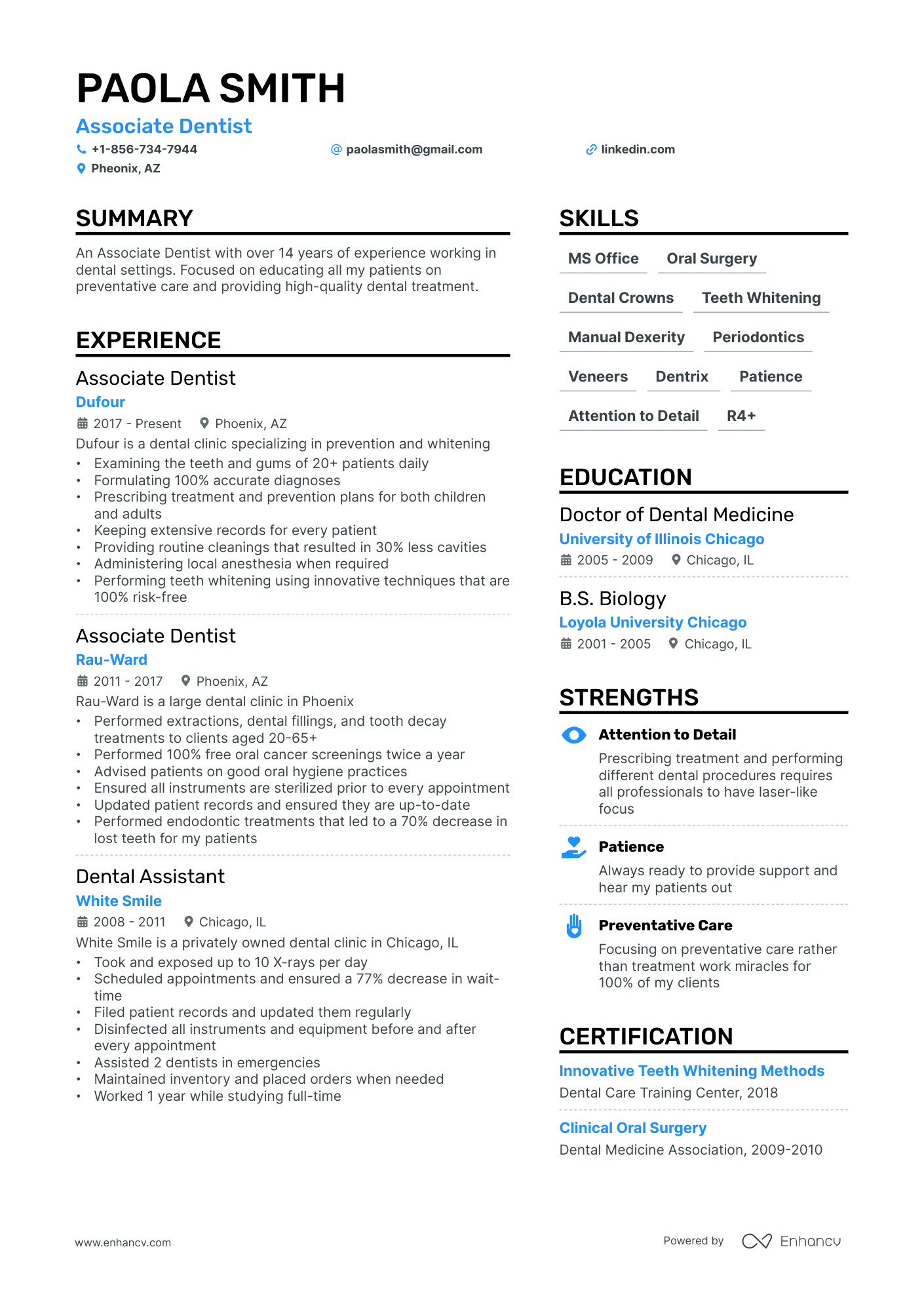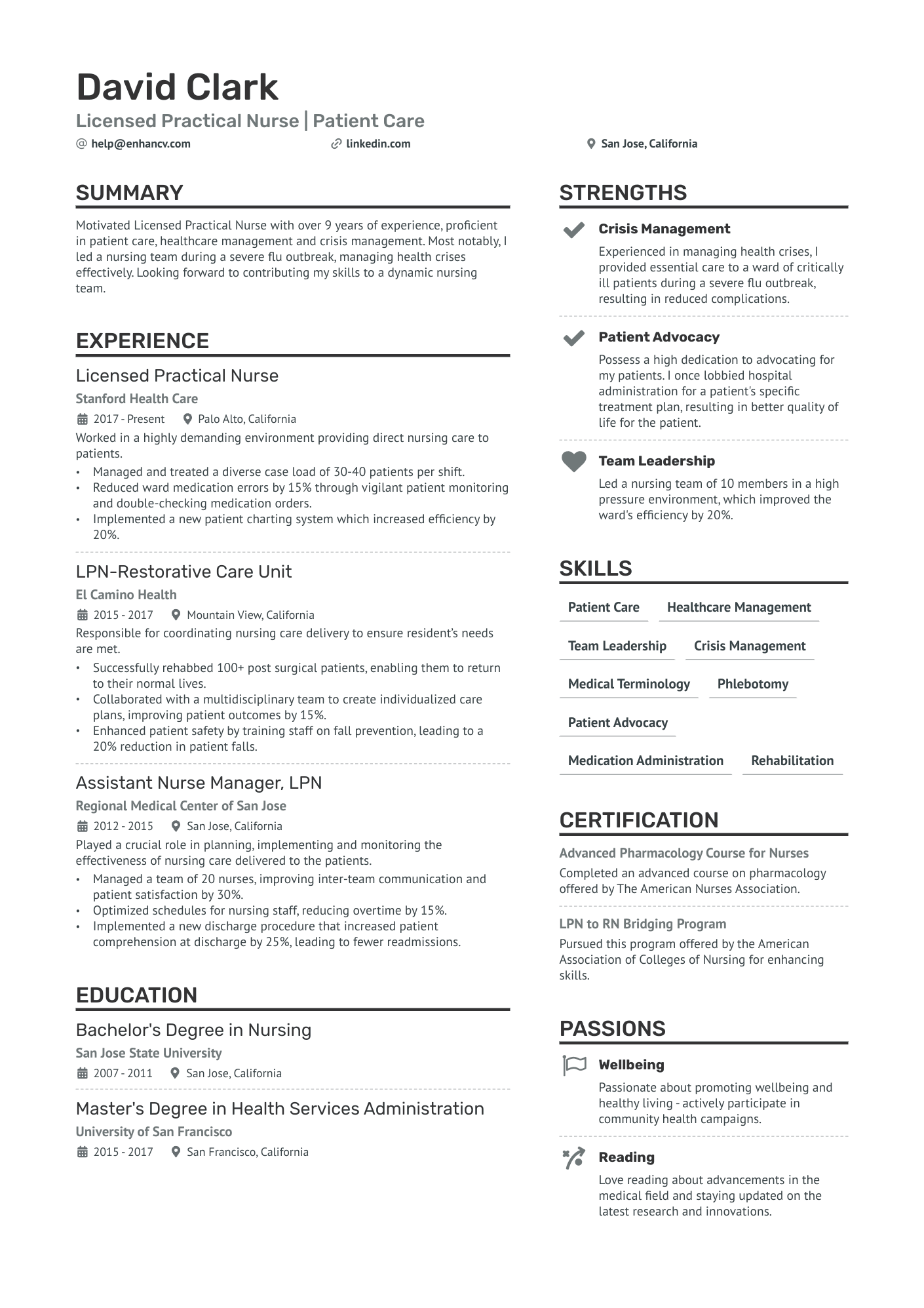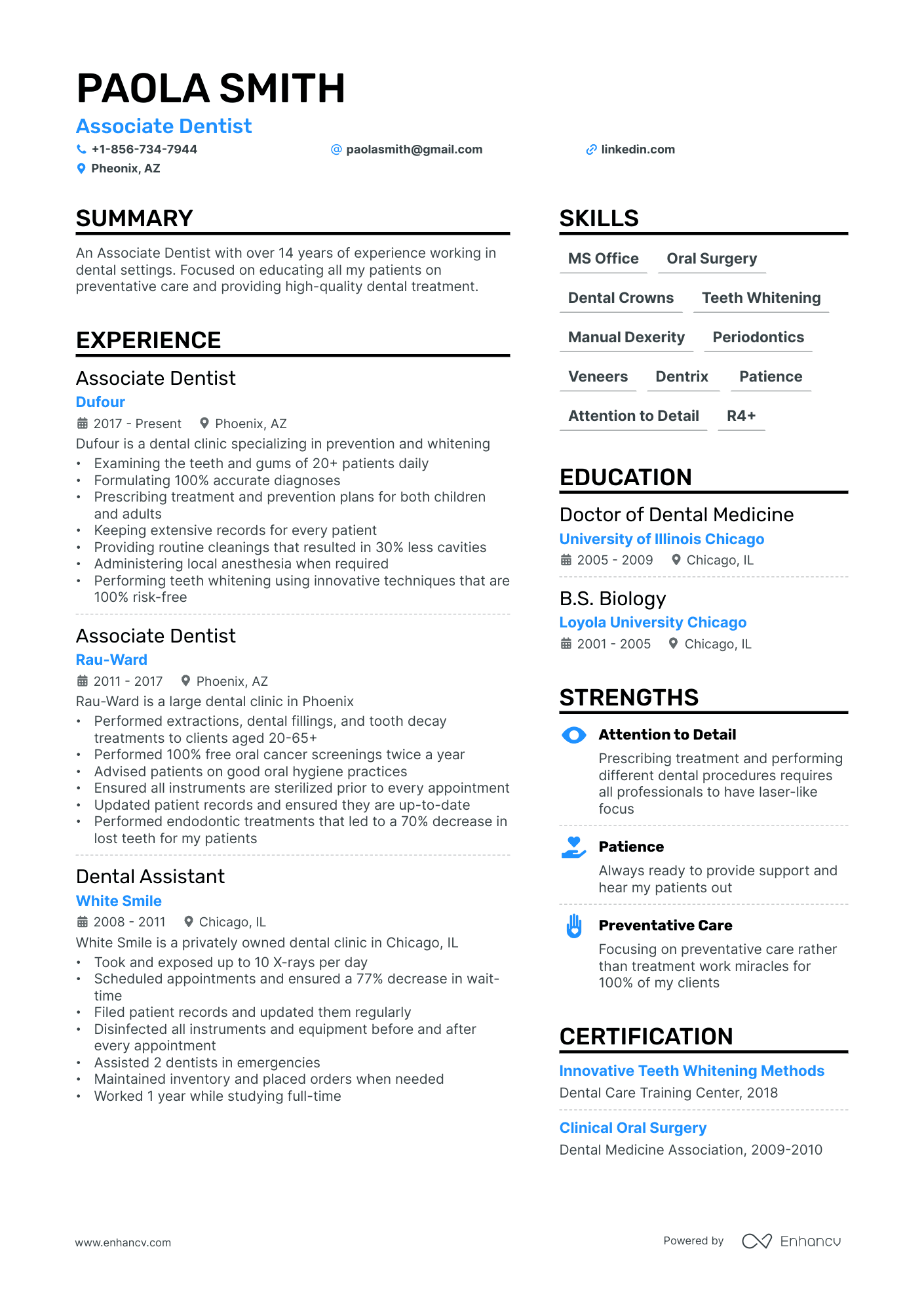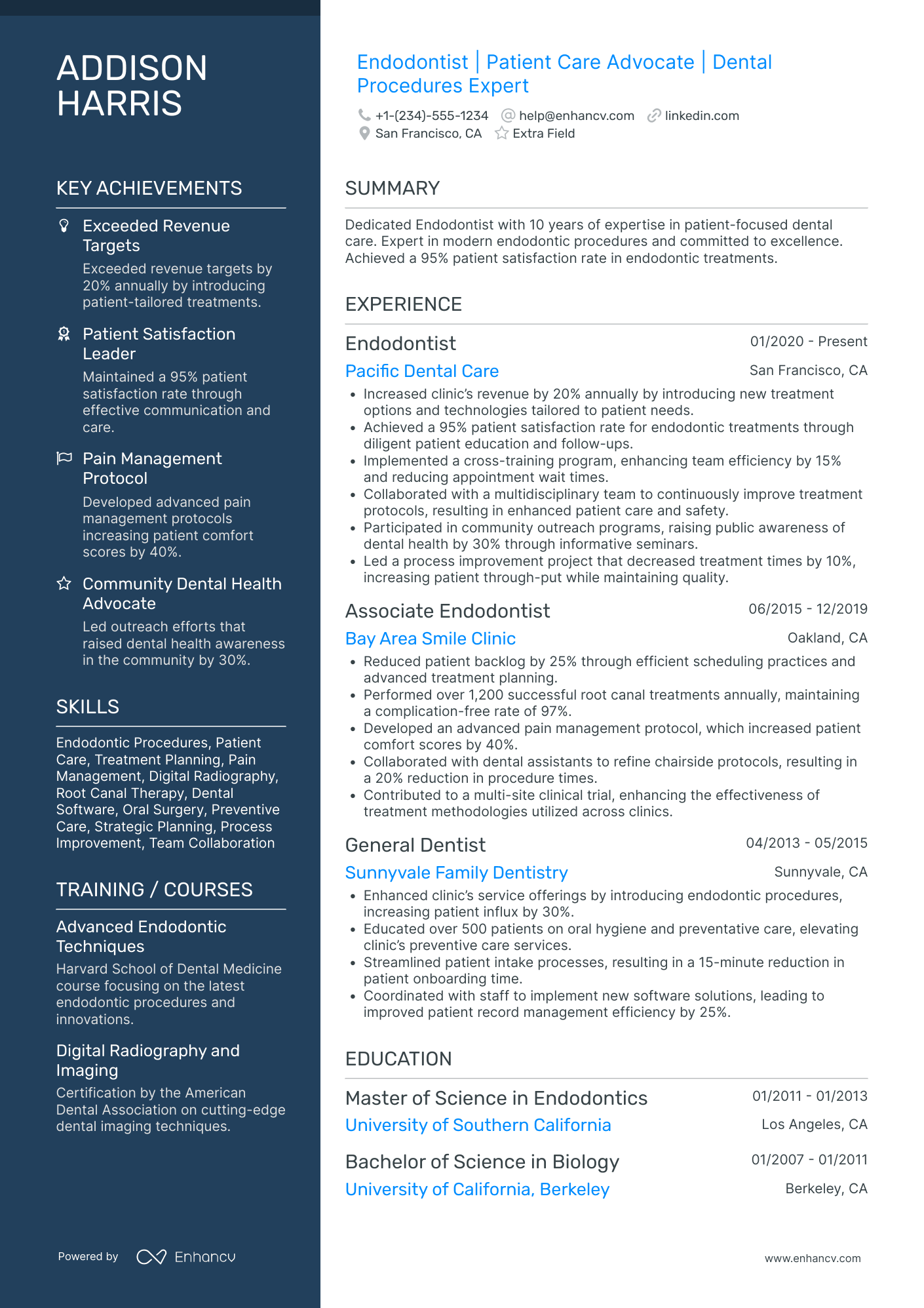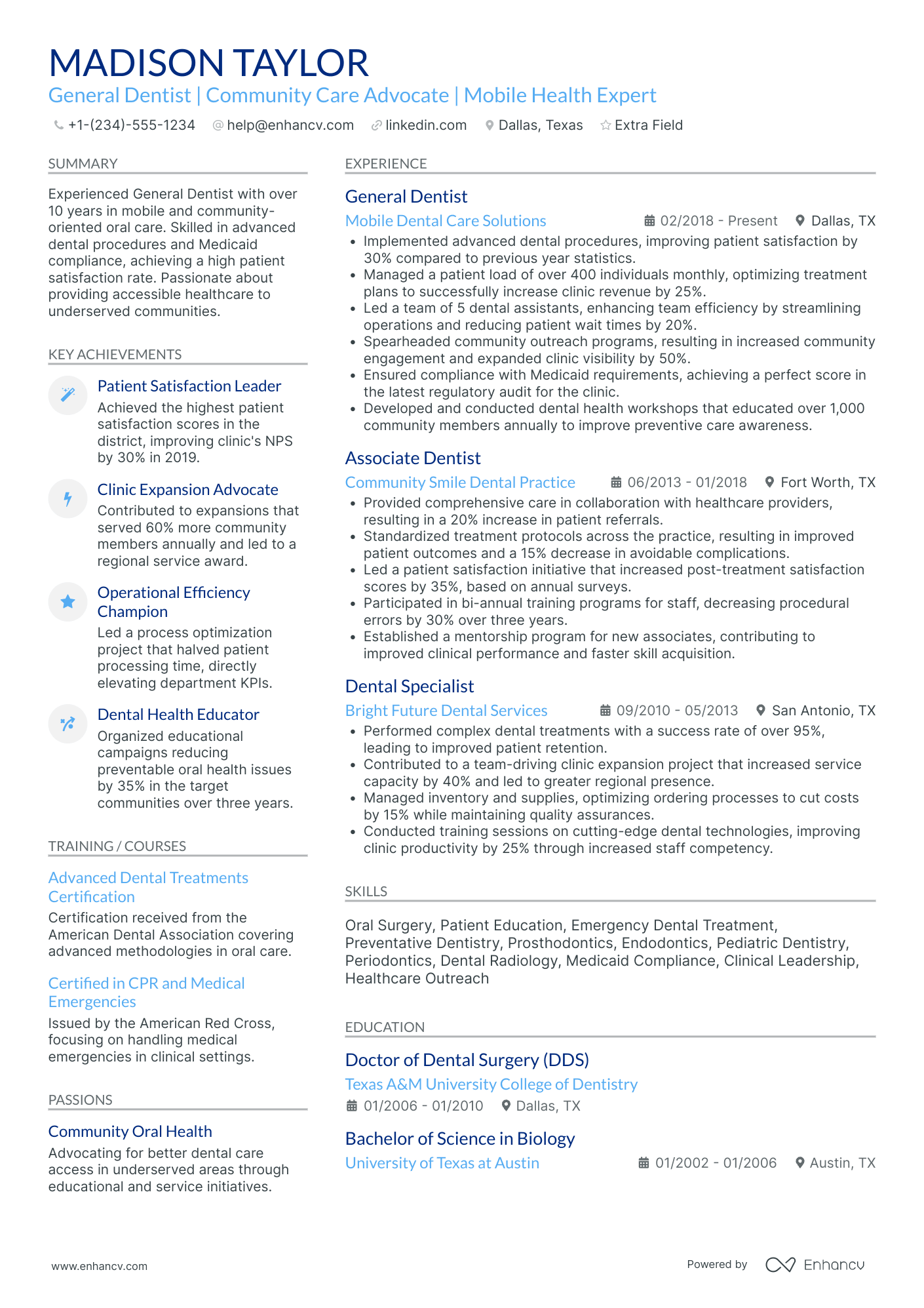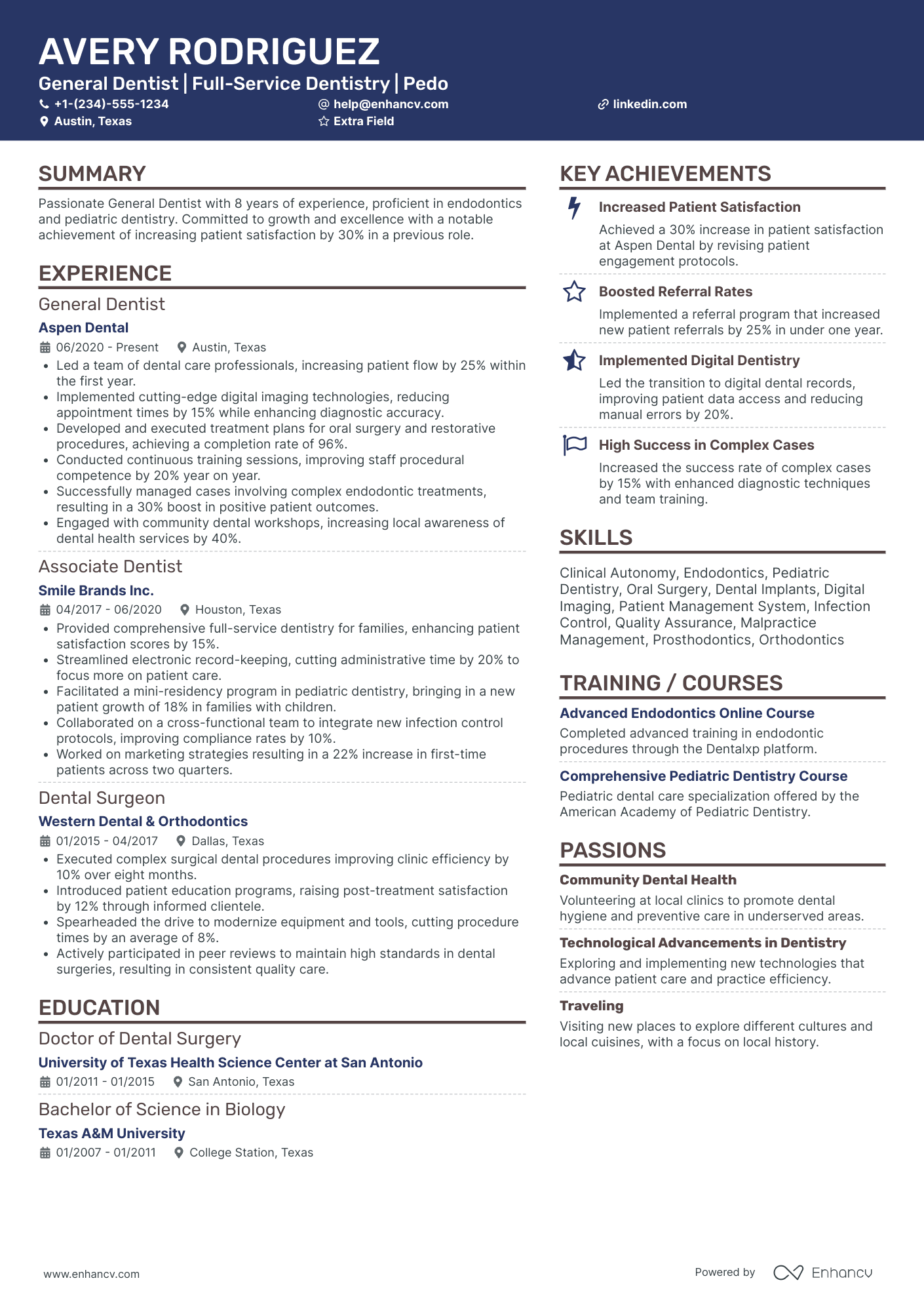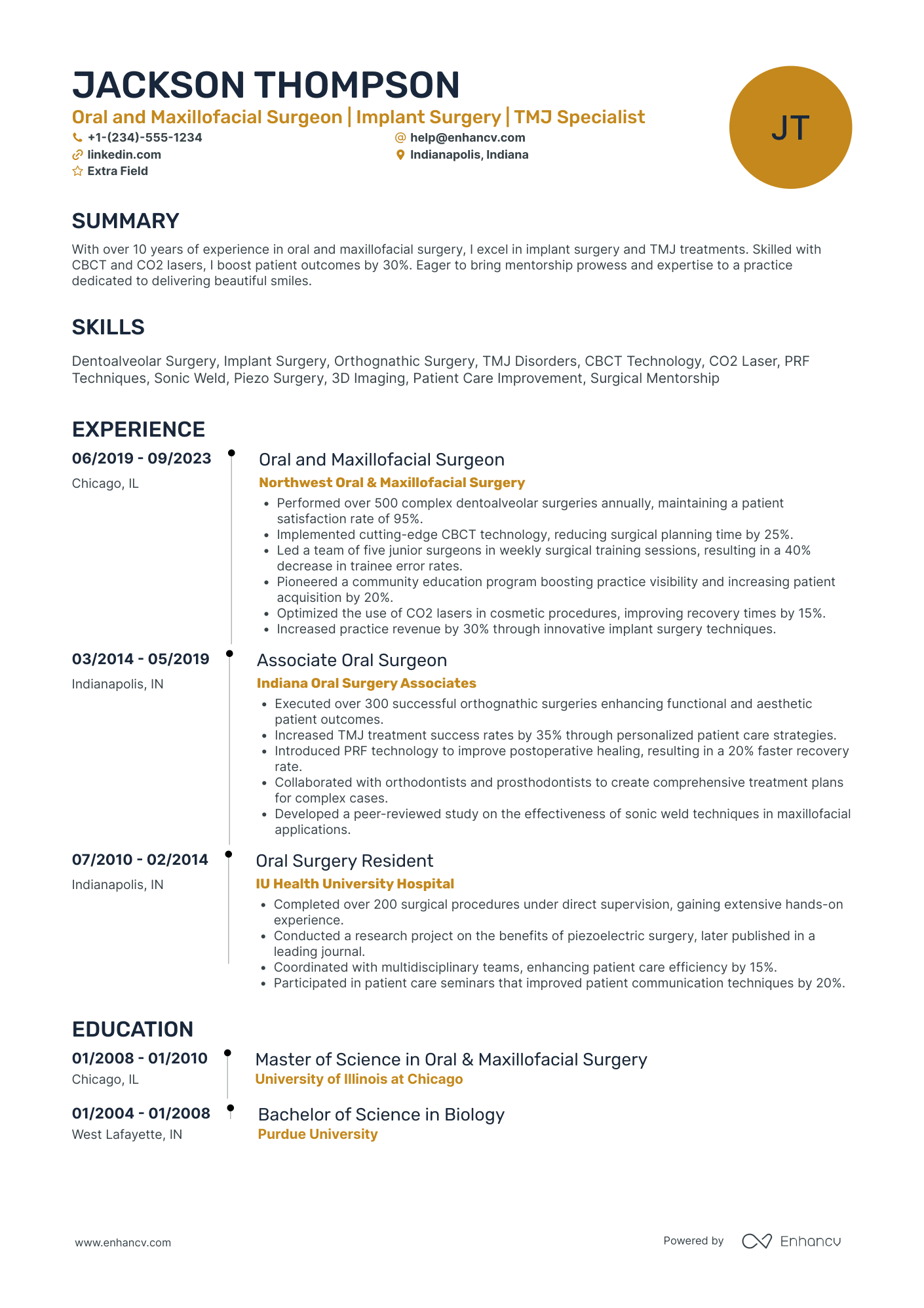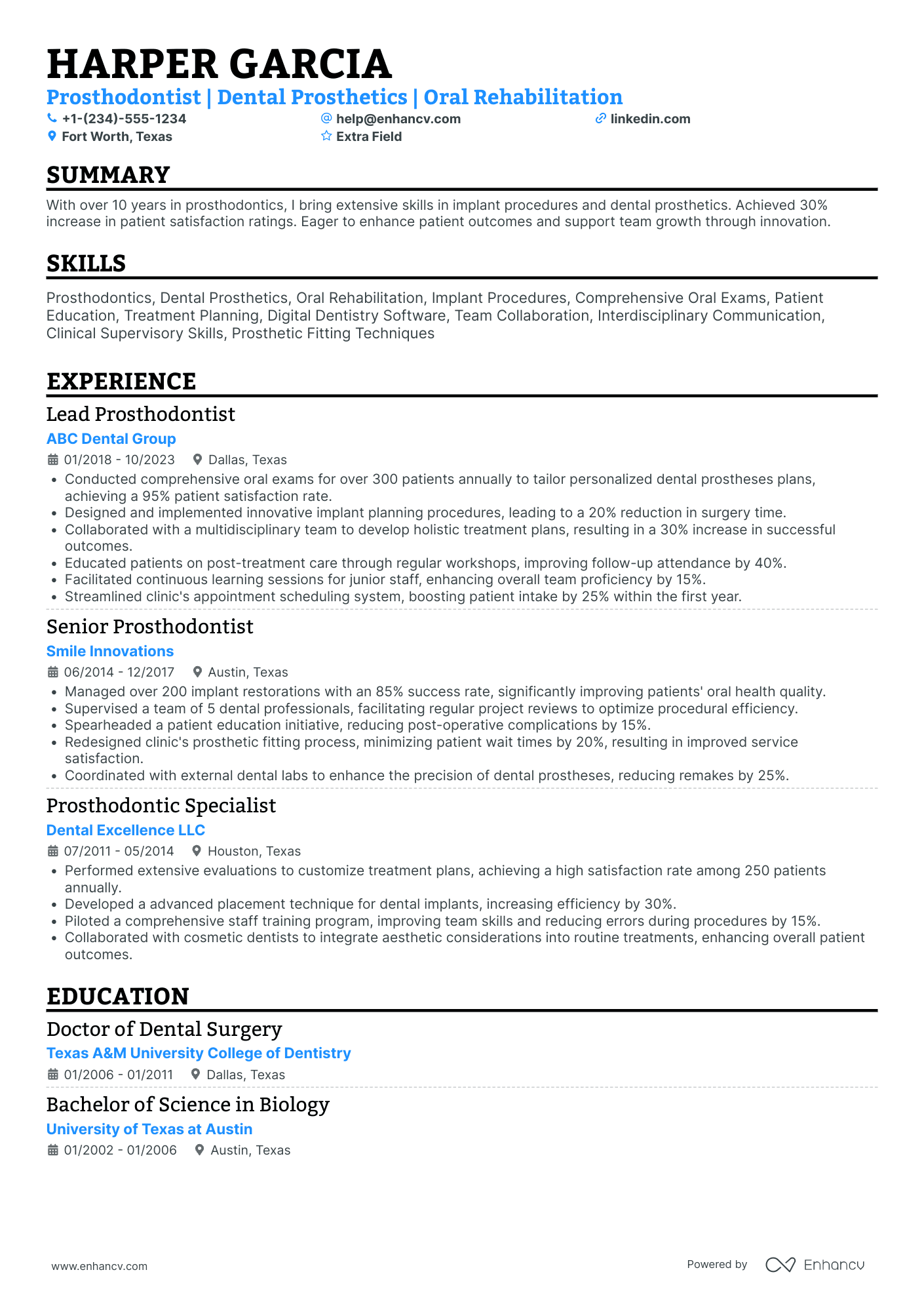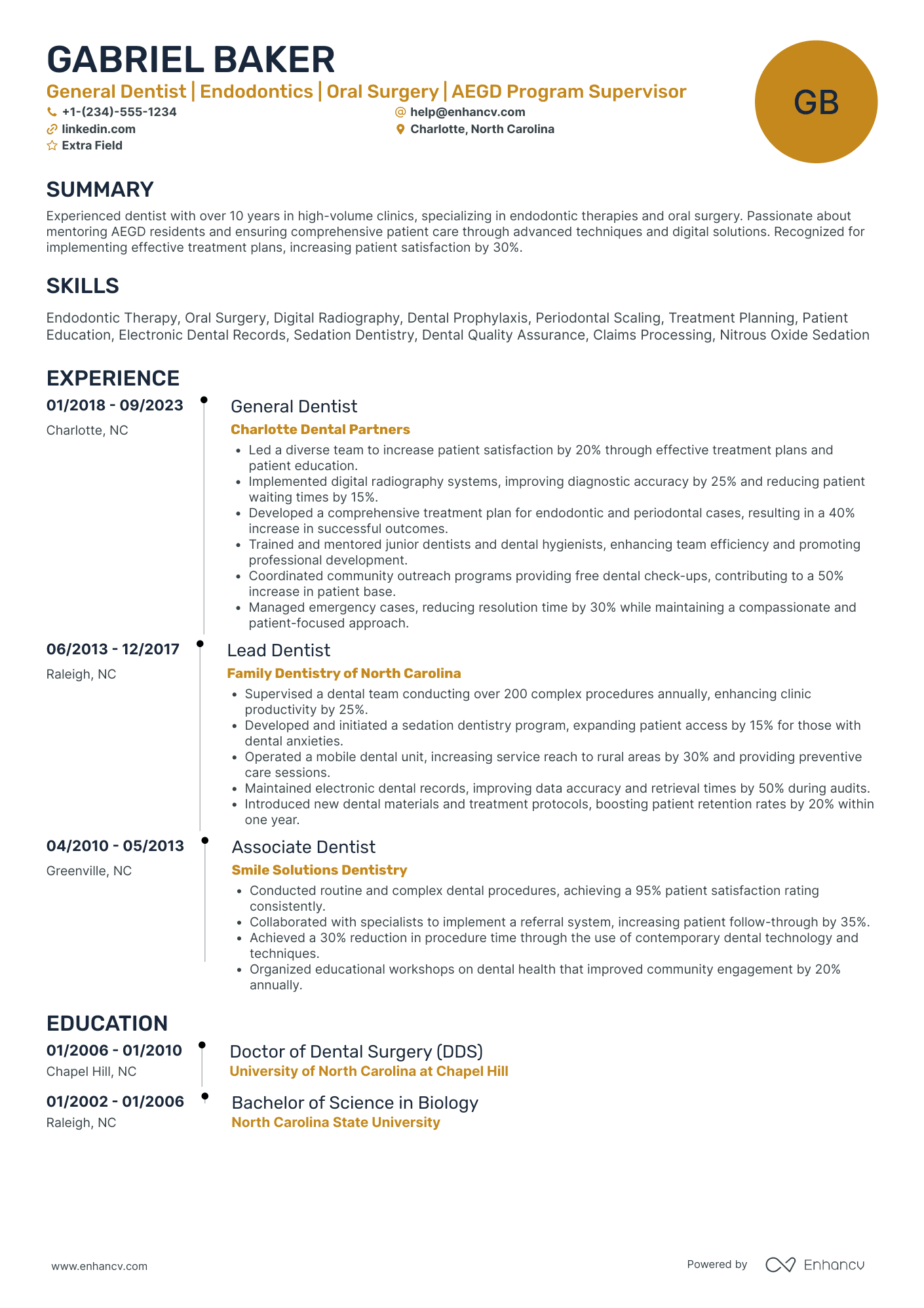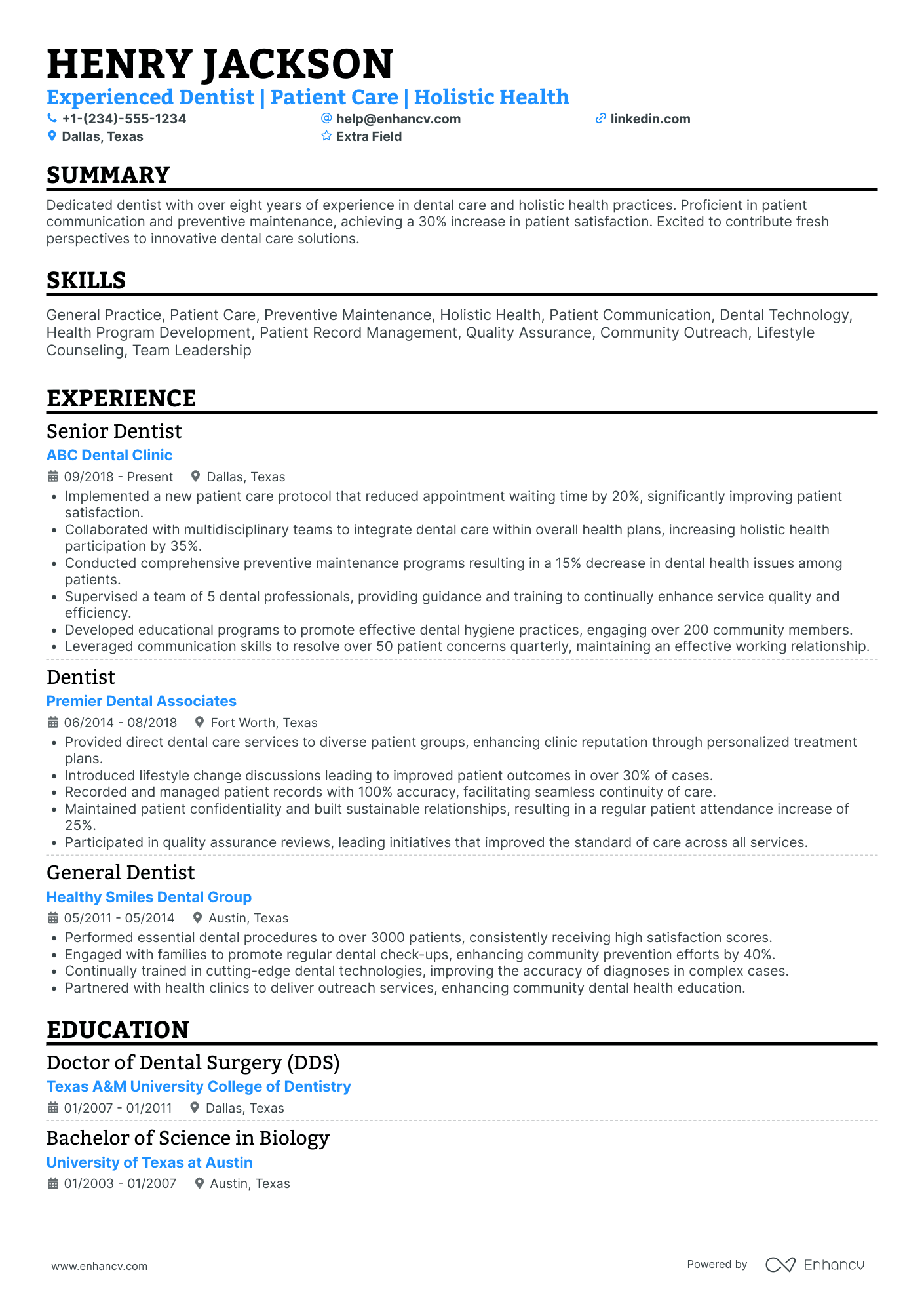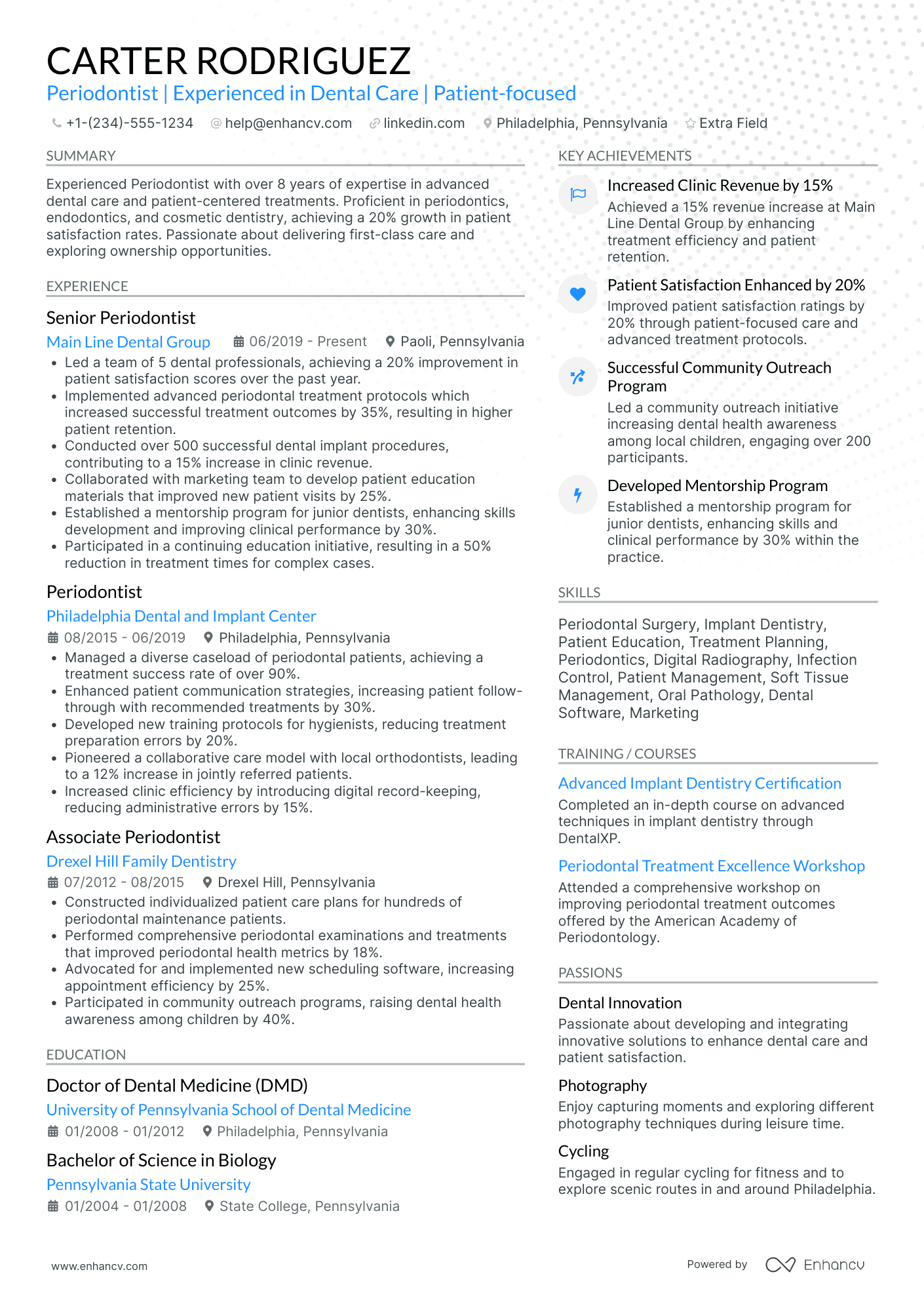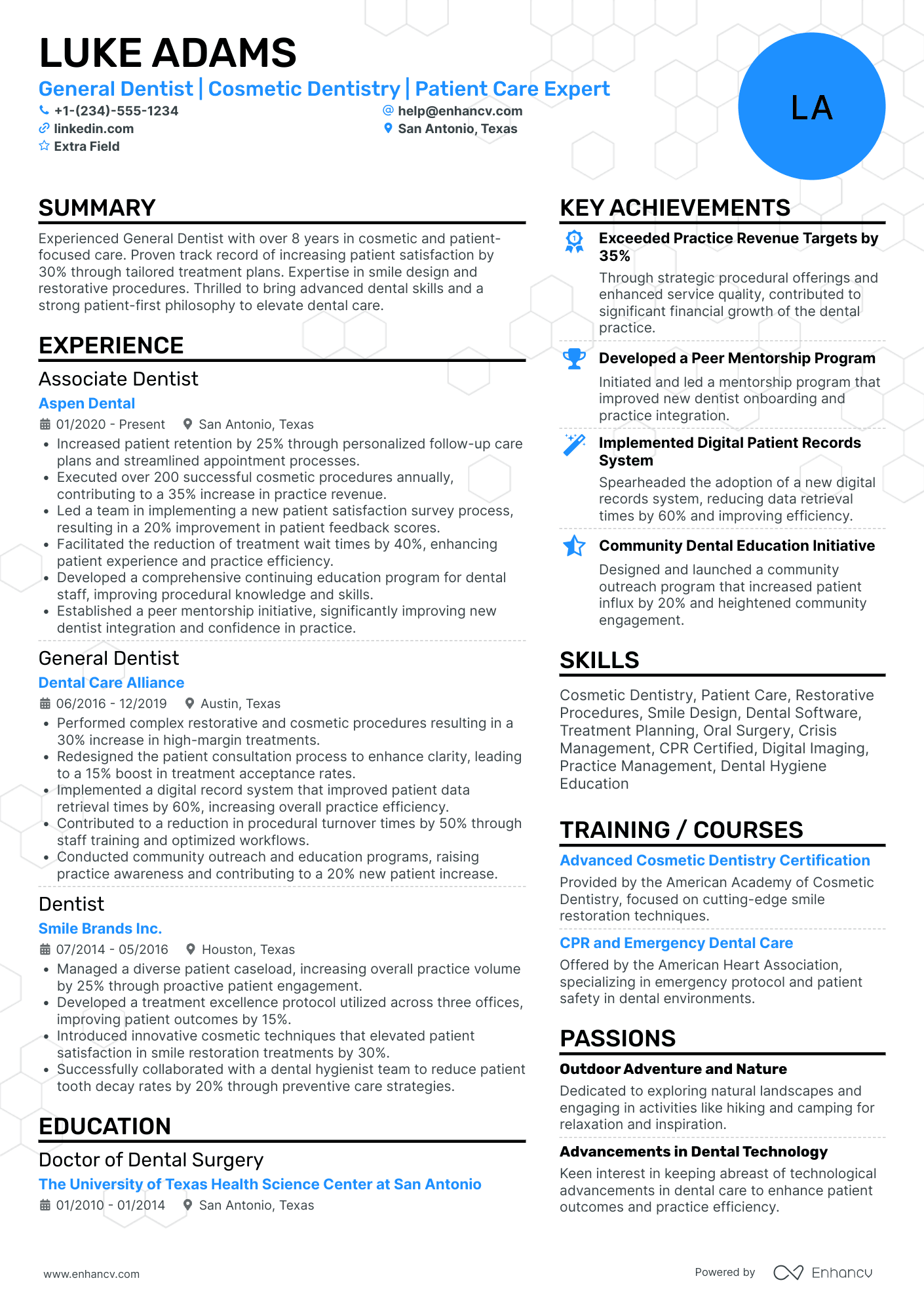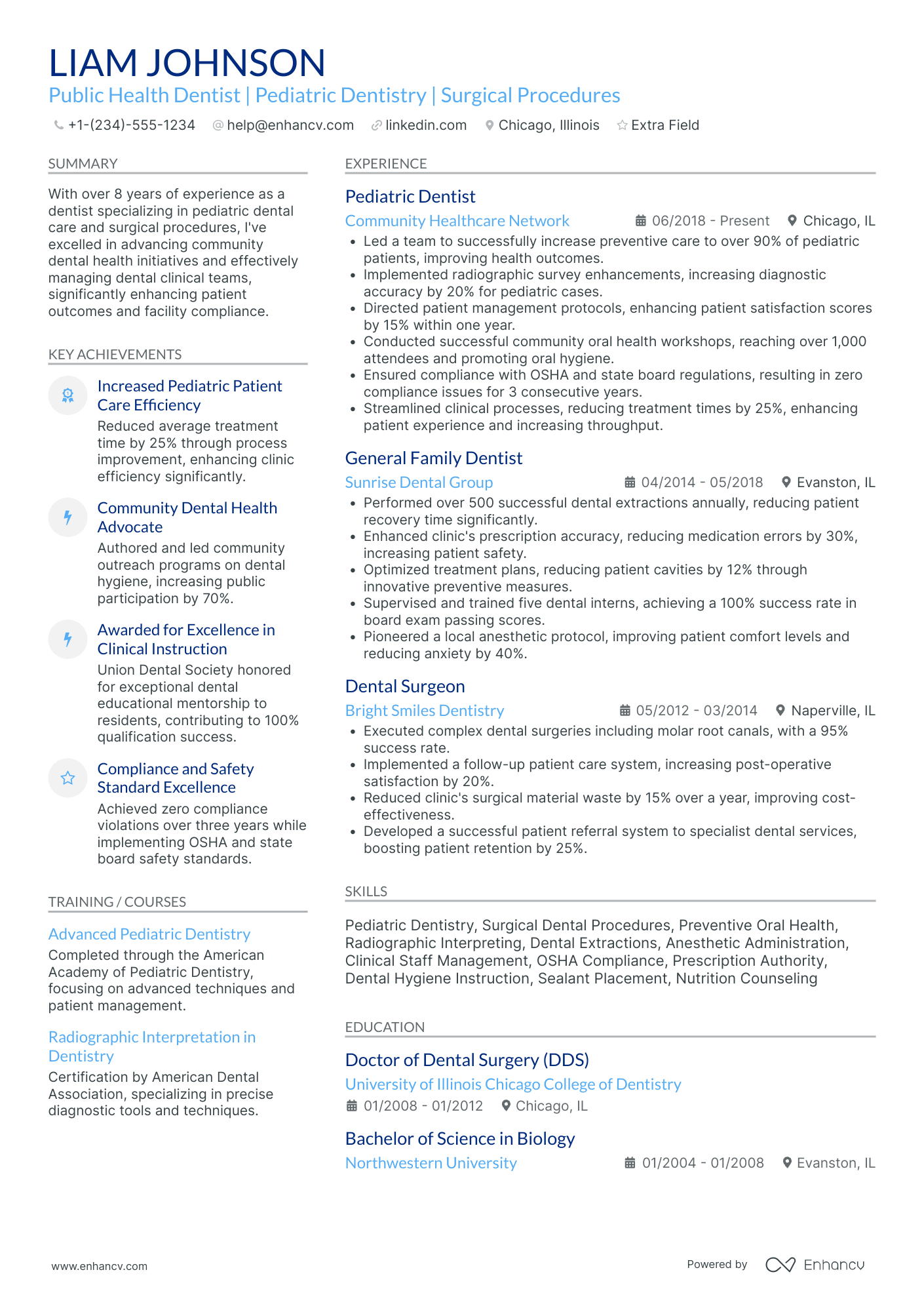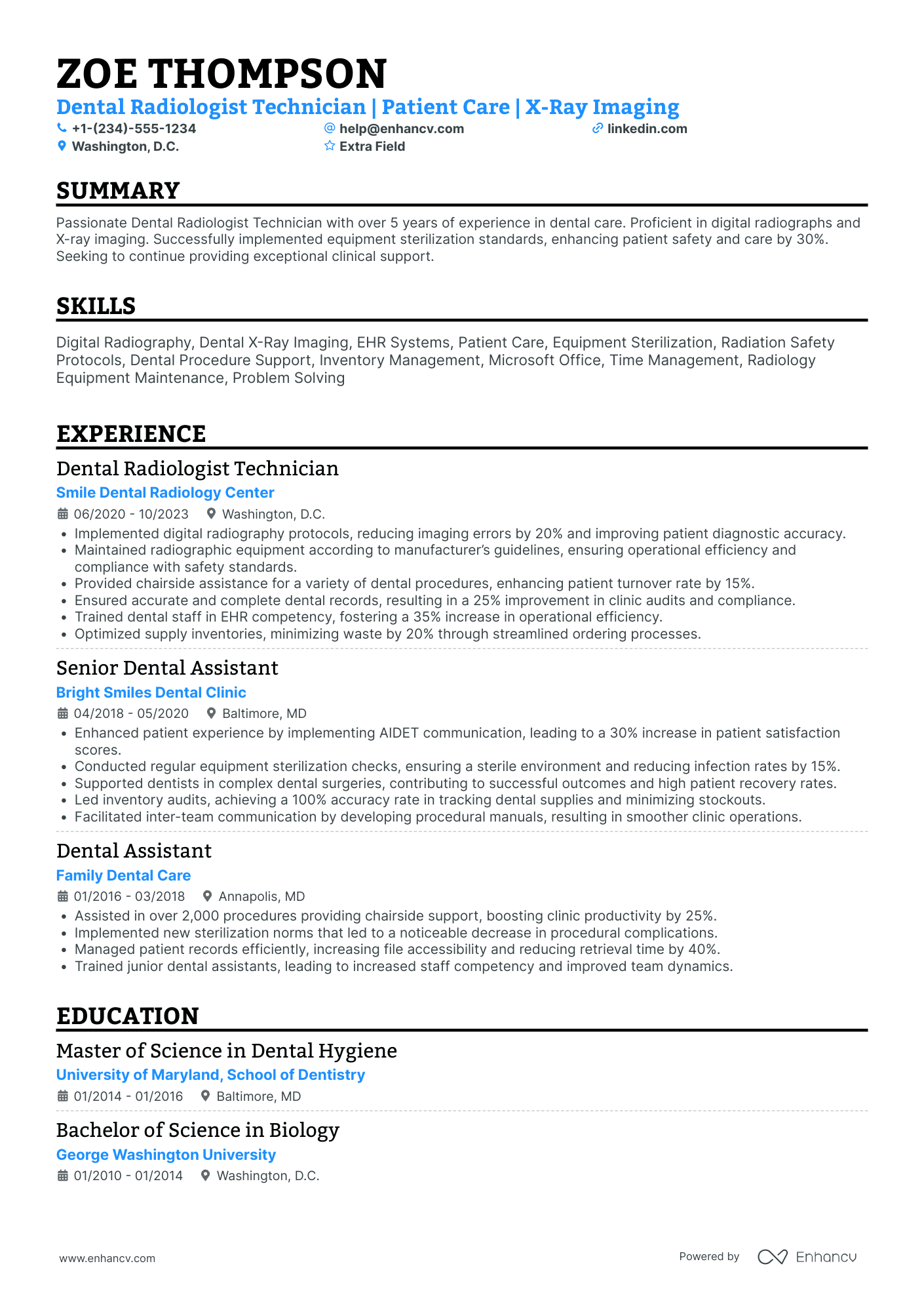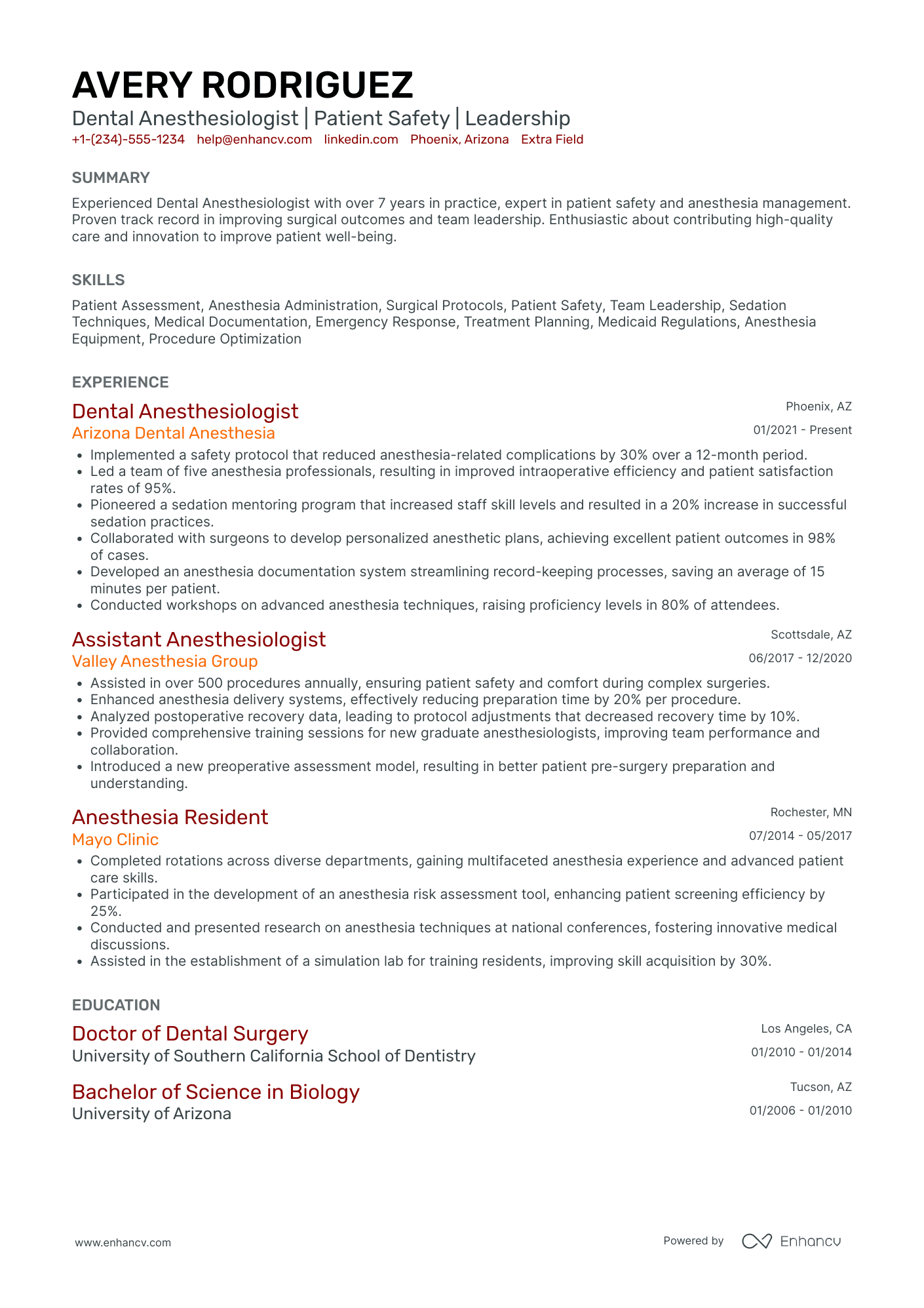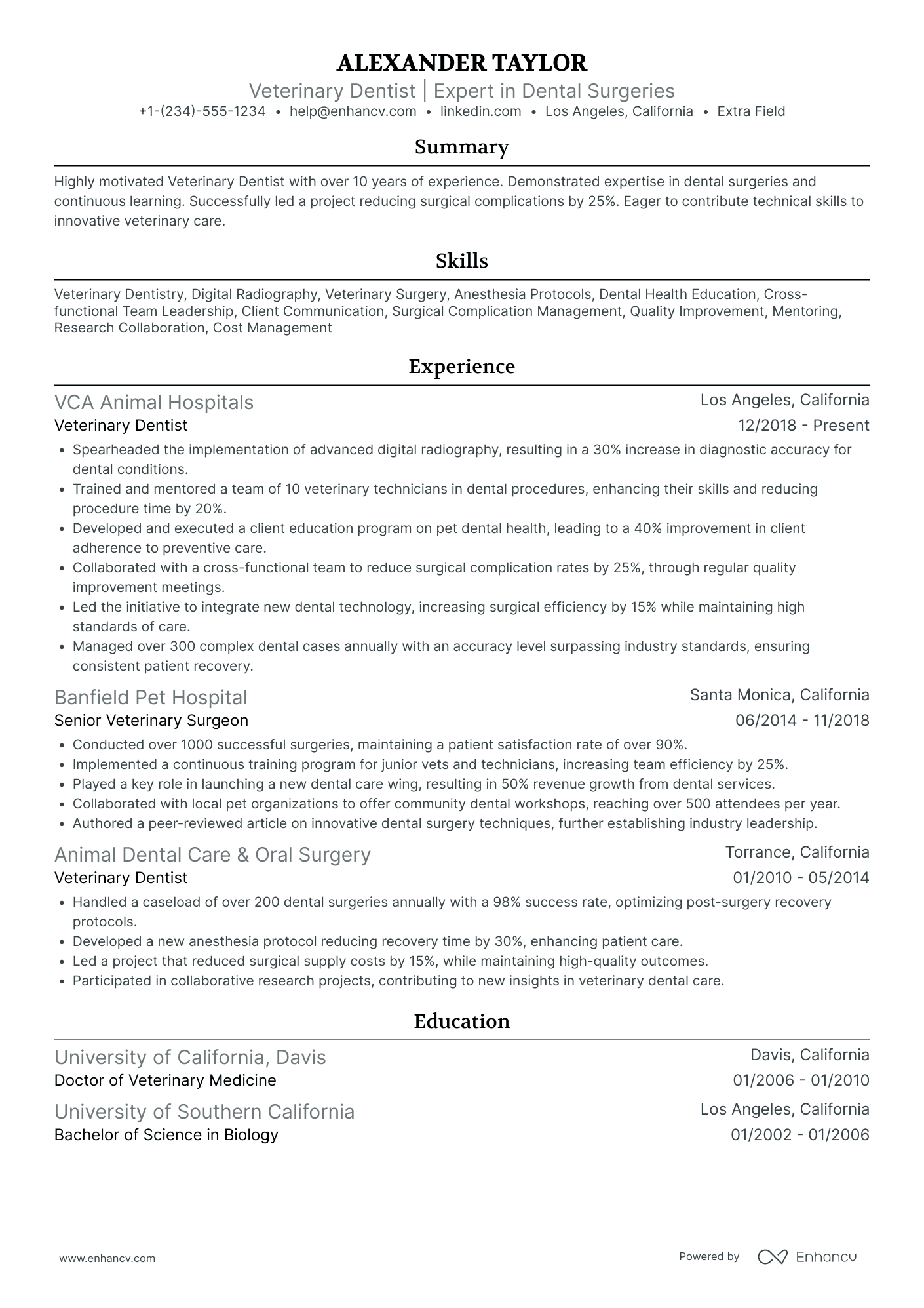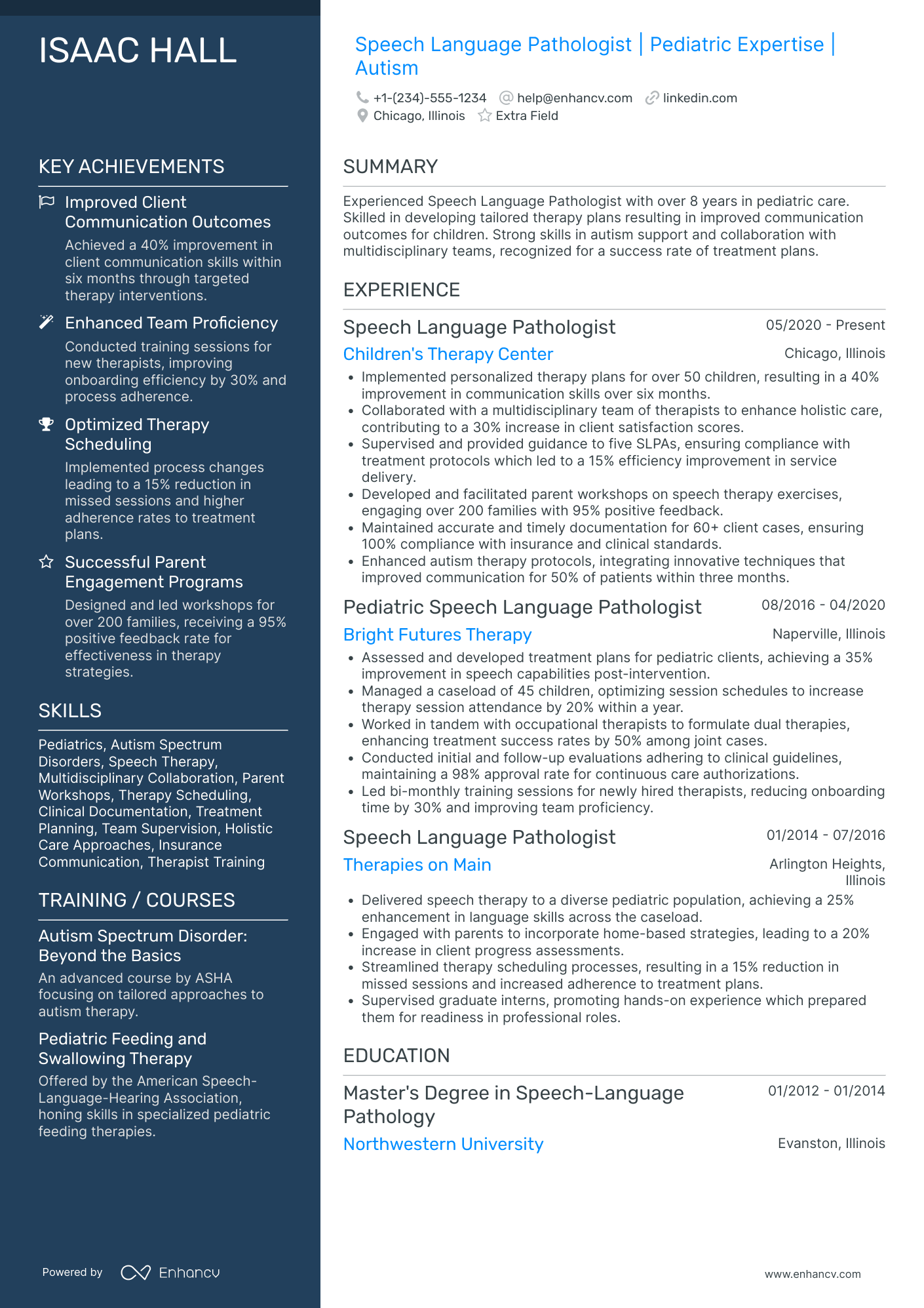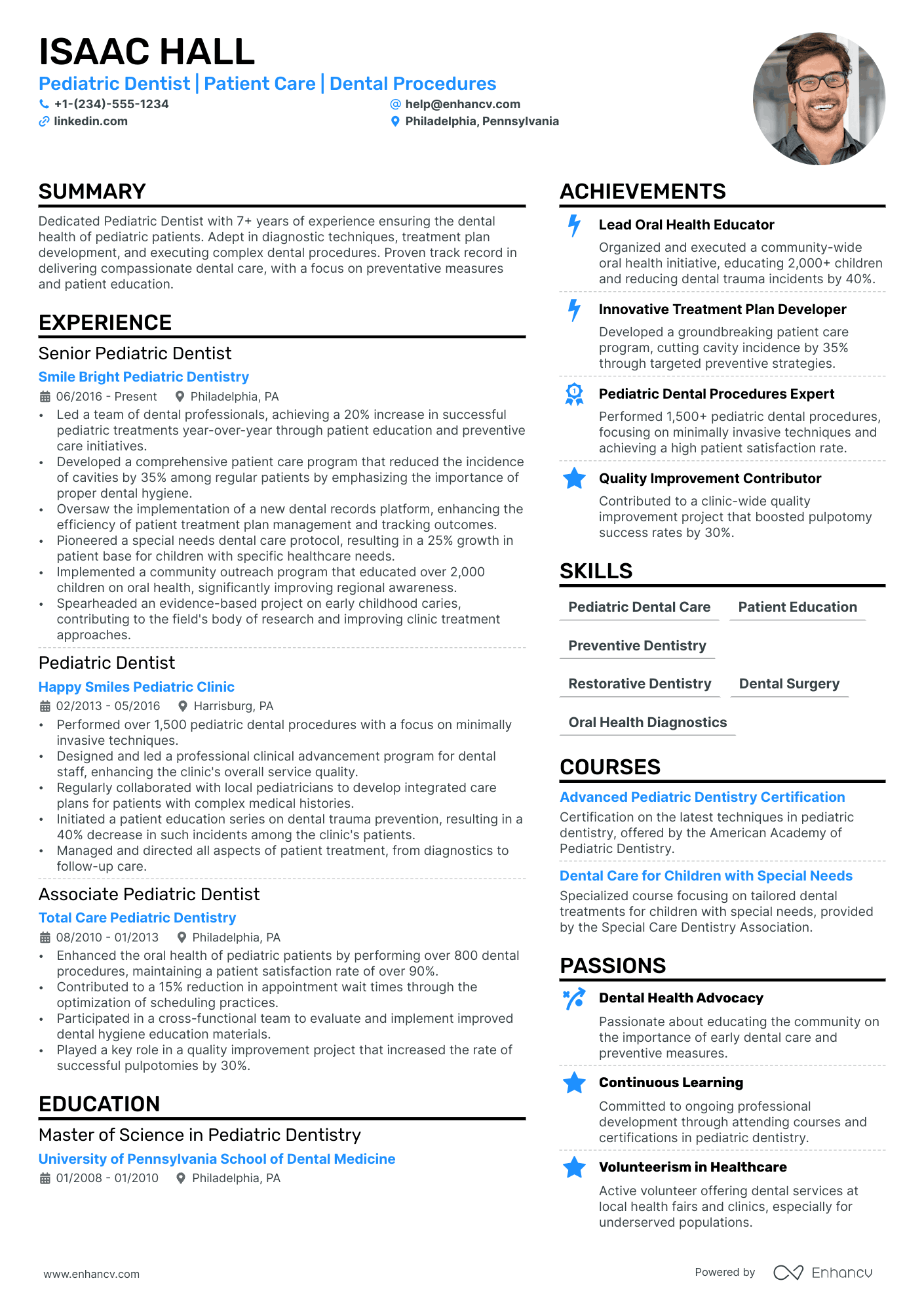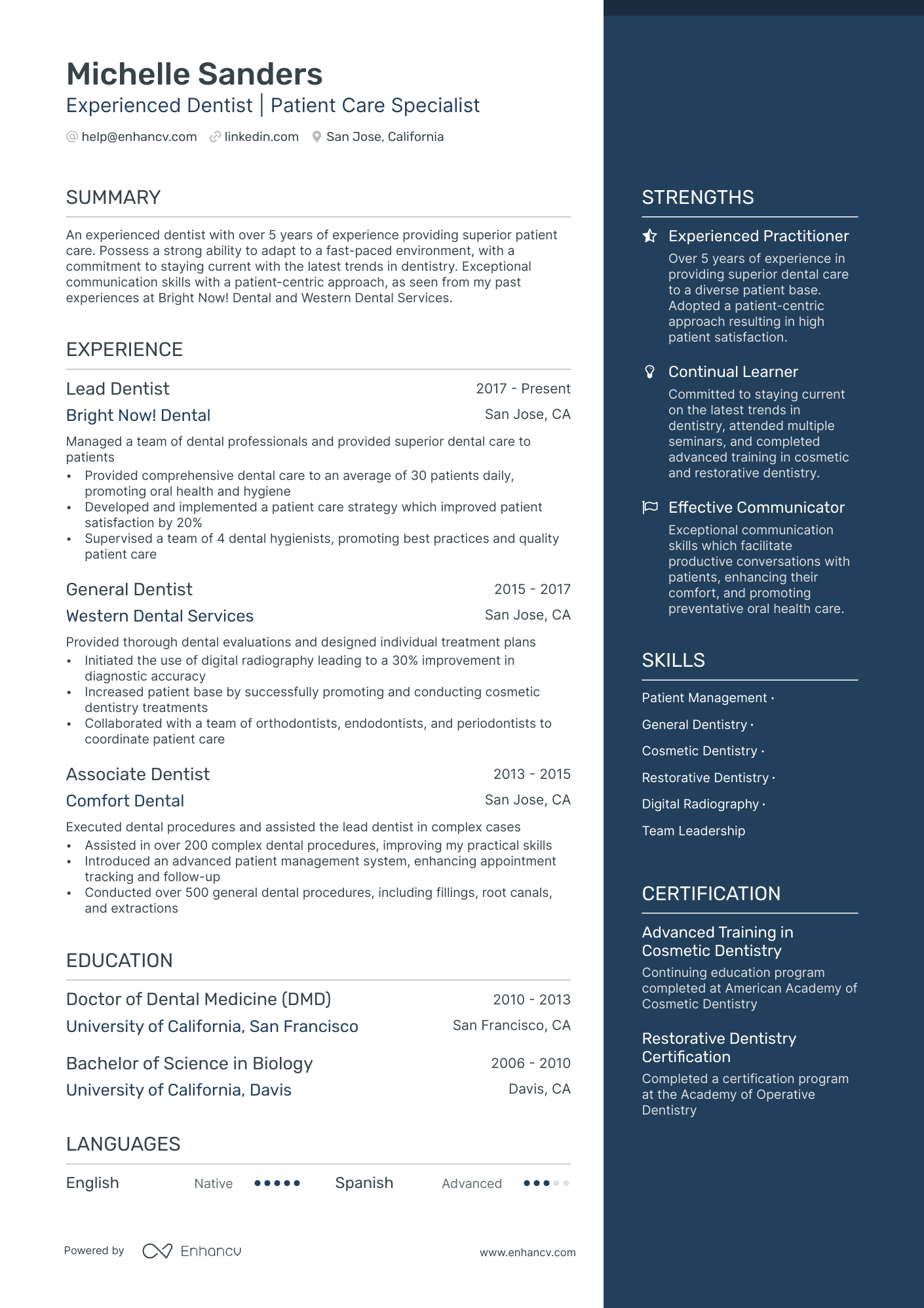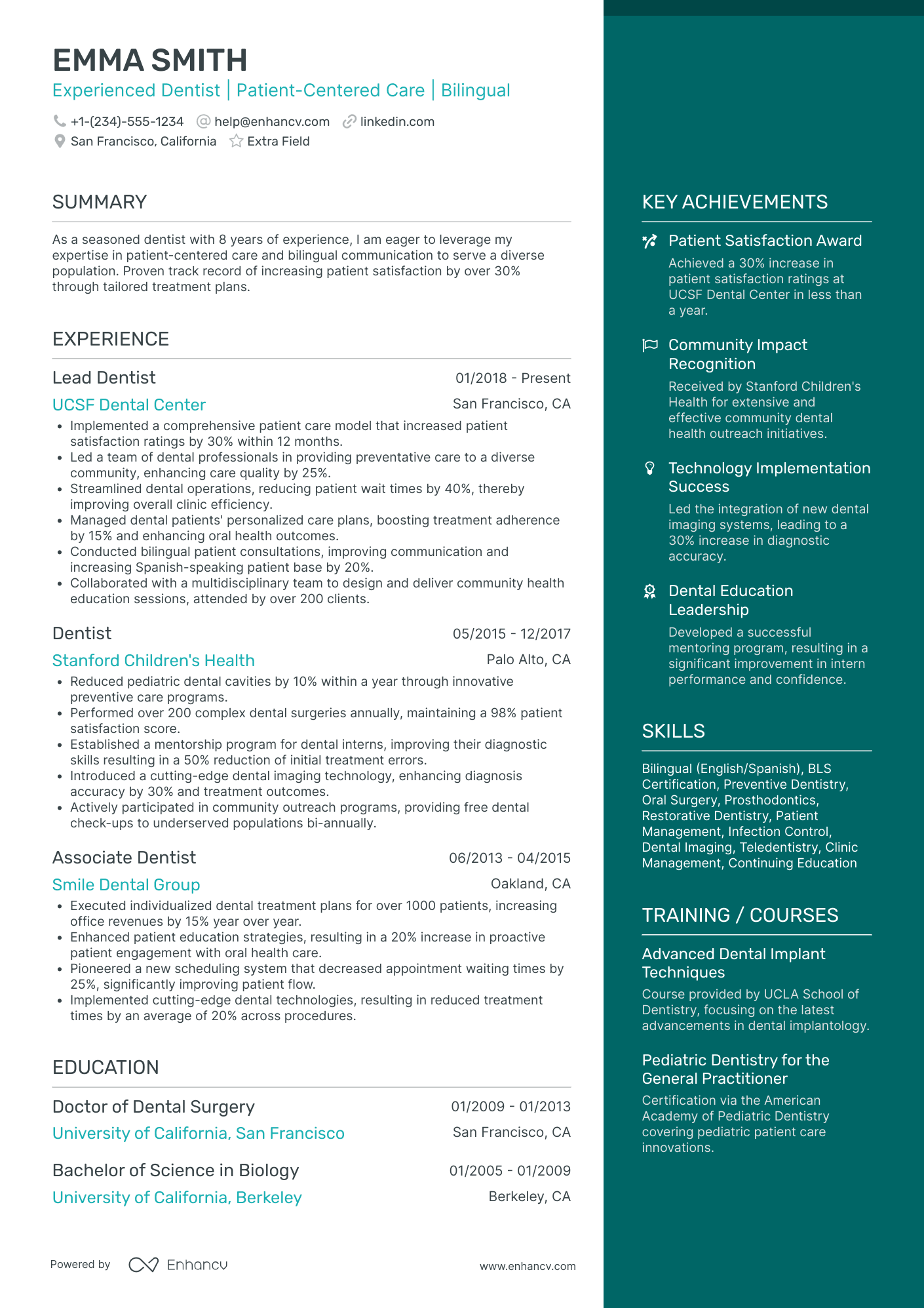Creating a dentist resume that shines as bright as the smiles you create presents some challenges for new and experienced dentists.
There are many different dental specialties that you can highlight on your resume. Those who don’t include the required skills and experience in requested specialized areas are likely not to make it to the first round of interviews.
In this guide, we will examine the most common issues dentists have when building an eye-catching resume and how to use each section to its full potential. We will use real-world resume examples to show you how to:
- Demonstrate technical abilities with specific tools and dental software in a way that recruiters and hiring staff can understand
- Highlight continued professional development with new technologies and dental procedures through continuing education, conferences, and memberships in dental associations
- Showcase a healthy mix of clinical skills, technical skills, and interpersonal skills
- Quantify dental metrics, such as patient satisfaction, recovery times, and number of procedures performed
If this resume guide does not fit with your career goals, check out these other resume examples for similar dentist positions:
Dentist resume examples
By Role
Associate Dentist
The Associate Dentist position often originates from the academic field of dentistry. Current trends in dentistry significantly impact the requirements and performance of associate dentists.
When applying for Associate Dentist roles, adhere to these tips:
- Demonstrate your experience with different dental procedures and treatments. This agnostic skills-set proves your ability to adapt to patients' needs.
- Highlight any experience or training with advanced dental technology or digital dentistry. This not only displays your technical skills but also your commitment to efficiency and patient comfort.
- Additionally, emphasize any specialized training or certifications. Do not simply list these qualifications, demonstrate how they improved patient outcomes or clinic performance. Follow the 'skill-action-results' pattern in your explanations.
Pediatric Dentist
General Dentist
Recent Graduate Dentist
Associate Dentist
Applying for an Associate Dentist position requires not just clinical practice but also updated knowledge on recent dental trends like CEREC, laser dentistry, 3D printing, and digital x-rays. Your resume should also feature any continuous education or certifications you've obtained, such as an Invisalign certification. Experience with dental practice management software like Dentrix or Eaglesoft is another bonus. Instead of only listing skills or achievements, illustrate how these contributed to improving a practice, like enhancing appointment scheduling or increasing patient satisfaction.
Endodontist
Forensic Dentist
Orthodontic Dentist
Oral and Maxillofacial Surgeon
Prosthodontist
Geriatric Dentist
Implant Dentist
Holistic Dentist
Periodontist
Cosmetic Dentist
Public Health Dentist
Dental Radiologist
Dental Anesthesiologist
Veterinary Dentist
Dental Pathologist
Before we start adding your education, work experience, and skill sets, let’s focus on the proper way to format your resume.
How to Format a Dentist Resume
Having a poorly formatted resume is like showing up at a wedding in cutoff shorts and a tank top. Unless everyone is dressed the same, you’re going to stand out, and not in a good way.
Your resume is the first impression recruiters and HR staff will get of you, and you want to present a polished, professional representation of yourself. The first step is to use the standard resume format:
- All sides are set to a one-inch margin.
- Line spacing is set to single-space.
- Font sizes can be set between 10-12 points.
- Keep your resume to no more than two pages.
- 1-inch margins on all sides
- Single line spacing
- Font size between 10-12 points
- A maximum of 2 pages
When choosing your fonts, go with a serif or sans-serif font. These are easier to read and more professional-looking than script, decorative, or handwritten fonts.
You can go with the classical choices of Arial and Times New Roman, but these are a little outdated. Fonts like Exo 2, Lato, Montserrat, Raleway, Rubik, and Volkhov are more modern fonts that can give your resume a cleaner look.
Enhancv resume templates come preset with the correct format, settings, and a long list of modern fonts, so you don’t have to worry about any of the technical specifications. You’ll need to choose which style of resume best suits you:
You’ll notice that each style has the option of a single or two-column format. Feel free to play around with each option and see which one works best for you. Dentists with more than 10+ years of experience can benefit from a two-column format. It allows you to add more technical skills, dental awards, and personal passions on one page.
When submitting your resume to a job post, be sure to save it as a PDF document (.pdf). This will preserve the look of your resume, and is accessible on most computer systems.
Customize your resume for the market – a Canadian format, for example, might vary in structure.
Is your resume good enough?
Drop your resume here or choose a file. PDF & DOCX only. Max 2MB file size.
If you have a resume ready to go, run it through our resume checker to see how well it stands up to other dentist resumes.
Let’s take a look at the top sections that you need to include on your resume:
The top sections on a dentist resume:
- Technical Skills: Detail-proven dental experience and clinical skills, along with technical expertise in standard and advanced dental equipment.
- State Licensing: Each state has its own licensing that you must have in order to practice dentistry.
- Education and Specialized Training: Highlight post-secondary degrees, medical degrees, and any advanced dentist training in periodontics, pediatrics, or maxillofacial surgery.
- Awards and Recognitions: List any local and national awards you received for outstanding dental achievements.
- Research and Publication: Include any research projects, studies, or published articles related to dentistry that you worked on independently or as part of a team.
Here are some of the areas that you want to focus on when adding details to your resume:
What recruiters want to see on your resume:
- Clinical experience and competency: Recruiters look for experience that demonstrates a candidate's ability to efficiently handle standard and advanced dental procedures.
- Specialized skills: Listing specialized training in orthodontics, prosthodontics, or endodontics showcases advanced training and your ability to handle multiple types of procedures.
- Communication and leadership: Dental practices want to see your interpersonal skills and how well you build relationships with your patients.
- Knowledge of regulatory compliance: An in-depth understanding of state and federal healthcare regulations and HIPAA compliance is required.
- Continuing education and professional development: Recruiters want to see that you are current with new dental tools and the latest procedures.
A better understanding of applicant tracking systems
Applicant tracking systems (ATS) are becoming more popular today as they assist HR staff in sorting through all of the resumes they receive for a single position. You may have heard some social influencers talk about the pitfalls of these systems, but don’t listen to their scare tactics.
This software works by allowing recruiters to enter industry-specific keywords and phrases into the system. It then bases its search algorithms on this information to find qualified candidates. This is why it is important to tailor your resume to the job post.
If the job calls for “general and restorative dentistry,” you want to include those keywords in your past work experience, resume summary, or skills section. While you don’t necessarily need to list them word for word, you do want to make sure that experience is included.
Now let’s talk about adding your past work experience in a way that highlights your clinical abilities, interpersonal skills, and business savvy.
How to Write Your Dentist Resume Experience
The resume experience section is where you will list your past work experience and demonstrate your knowledge in general dentistry, pediatric dentistry, cosmetic dentistry, and other advanced skills.
Each entry should include the following:
- Job title
- Company name and location
- Company bio
- Dates of employment
- 4-8 bullet points detailing your work experience
Keep in mind that you have limited space. Only list relevant work experience and no more than three job entries. Be sure to list each entry in reverse chronological order, as this is the standard way to list past work experience.
To give you an idea of what to do and what not to do in your dentist resume experience section, we will use a real-world example to demonstrate:
- •Promoted preventative care and educated patients on proper oral hygiene
- •Collaborated with dentists to design disease treatment plans
- •Performed basic procedures, extractions, root canals, and restorative works
- •Prescribed medications for pain management
- •Examined patients after restorative care
In this example, we get a very brief description of their duties, but it fails to really define how well they performed their job. This is something that recruiters read every day and are fully versed in the duties and responsibilities of the job. What they need to know is how well you performed these duties.
When you list your work experience, you want to answer the following question: How did you use your skills and experience to benefit the practice and its patients?
Our first example doesn’t really answer that question, so we will try and fix that by adding a little more details:
- •Promoted preventative care and educated patients on proper oral hygiene, decreasing the number of cavities in patients by 31%
- •Collaborated with 3 dentists to design disease treatment plans for patients with periodontitis, root infections, and dry mouth
- •Performed basic dental procedures, including extractions, root canals, and restorative works for 14-17 patients per day
- •Prescribed medications for pain management and called patients 2-3 days after surgery to check for recovery progress
- •Examined patients after restorative care with a follow-up appointment within two weeks of procedure
We now have a more defined picture of this person's skills and the effect they had at their previous job. This example does a great job of:
- Showcases a significant decrease in patient’s cavities
- Demonstrates teamwork in developing specific treatment plans
- Highlights daily caseload for general dentistry
- Details of patient management procedures
Next, we will go over some ways that you can quantify certain metrics to improve your chances of getting a new job.
How to quantify impact on your resume
One of the best ways that you can create a tailored resume is by adding numbers and percentages when detailing various dental processes, treatment procedures, and other metrics.
This is one resume technique that many dentists fail to utilize because it is more difficult to quantify the impact on medical procedures and patient care methods. You may have to dig a little deeper to find measurable results that will impress future employers.
Let’s take a look at some examples of the metrics you can quantify on your dentist resume:
- Procedures carried out: “ Performed oral surgery, restorative, fixed, and removable prosthetic treatments, and utilized endodontic treatments using the Dentsply-Tulsa system on 30% of patients.”
- Patients managed: “Performed general dental services, including restorative dentistry on 13-15 patients per day.”
- Percentage of successful procedure or recovery rates: “Scheduled follow-up appointments and phone/facetime calls for patient recovery after maxillofacial and reconstructive surgeries, which led to a 28% increase in recovery times.
- Years spent in specialized dental training: “Completed a 48-month Maxillofacial Surgery Residency Program at the University of Arizona College of Medicine.”
- Increases in revenue: “Coordinated with the dental team to develop new care plans for patients, which increased general dentistry appointments by 73%.”
- Dental emergencies: “Performed, on average, 5-8 dental emergencies each month, including broken or chipped teeth, removing abscess, repairing loose or broken braces, and severe soft tissue injuries.”
- Percentage of patient care improvements: “Educated patients on oral health and proper detailed hygiene, including routine brushing and flossing, which led to a 48% decrease in patient cavities.”
- Reduction in Procedure times and efficiency improvements: “Specialized in GC Fuji TRIAGE radiopaque glass ionomers to prevent fissure caries, which decreased surgery times for broken or chipped teeth by 24%.”
While you don’t need to quantify every line, you want to focus on what is listed in the job post. Let’s say you are interested in a job post with the following responsibilities:
Responsibilities:
- Conduct thorough dental evaluations, diagnose patients, and develop personalized treatment plans.
- Ensure exceptional quality of care by adhering to the highest standards of dental treatment and staying up-to-date with the latest advancements in the field.
- Establish and maintain positive relationships with patients, providing a comfortable and reassuring experience throughout their dental journey
- Educate patients on oral hygiene practices and the importance of post-treatment care.
There are several metrics that you can quantify here, such as patient satisfaction and retention:
“Worked with dentists and staff to update check-in/check-out procedures, patient follow-ups, and savings plans that produced a 48% increase in patient satisfaction ratings and a 25% increase in return visits from first-time patients.”
Let’s focus a little on how to create a dentist resume with no experience and the types of jobs you can list that highlight your relatable skills.
How do I write a dentist resume with no experience
Every great dentist once stood on the shores searching for their first dentist job.
It can take anywhere from 10-14 years to complete education and training to become a practicing dentist. During that time, you may have worked in a dental office, hospital, or university, where you used the skills necessary to become a dentist.
The resume experience section for first-time dentists should include those internships and part and full-time jobs where you performed some of the following tasks:
- Educated patients on dental care
- Performed research on oral health developments and new technologies
- Assisted in dental procedures
- Worked as a teacher or other positions in academia
A first-time dentist resume experience section will look something like this:
Notice how each job shows a progression in their career. This is what first-time dentists want to aim for when adding relevant work experience.
In the next section, we will dive into how to add your technical, clinical, and interpersonal skills.
How to List Your Hard and Soft Skills on Your Resume
dentists need to showcase a number of different skill sets to impress their future employers. These skills will demonstrate your abilities to perform procedures safely and efficiently (clinical knowledge), keep the practice profitable (business and marketing skills), and maintain a healthy relationship with patients (people skills).
Hard skills are those technical and clinical skills that you pick up through college courses, dental school, residencies, advanced dental training, and real-world experience. Your hard skills include technical knowledge of dental procedures, equipment, medications, and HIPAA rules and regulations. They also cover other business-related skills to help you manage a practice and make it more successful.
Soft skills include more personal skills that you pick up through daily interactions with your family, friends, and peers. They include necessary skills such as emotional intelligence, time management, and the ability to discern technical information so your patients can understand it.
Enhancv Skills and Technical sections are the best places to list your hard skills:
Best hard skills for your dentist resume
- Root Canal Therapy
- Dental Implant Placement
- Orthodontics
- Prosthodontics
- Periodontal treatment
- Oral surgery
- Pediatric dentistry
- Sedation dentistry
- Tooth Extraction
- Cosmetic dentistry
- Dental software proficiency (for example: Dentrix, Eaglesoft)
- X-Ray Interpretation
- CEREC Crowns
- Advanced Cardiac Life Support (ACLS)
- Local Anesthesia
- Nitrous Oxide Sedation
- Invisalign Treatment
- Cone Beam Computed Tomography (CBCT) Analysis
- Dental Laser Technology
- Dental Prophylaxis and Scaling
To include your soft skills, use our Passion section or Talent section to list your soft skills.
Best soft skills for your dentist resume
- Patient Management
- Communication Skills
- Empathy
- Interpersonal Skills
- Critical Thinking
- Problem Solving
- Attention to Detail
- Time Management
- Organizational Skills
- Stress Management
- Team Collaboration
- Leadership
- Adaptability
- Ethical Conduct
- Passion for learning
- Patience
- Open-mindedness
- Cultural Competency
- Negotiation Skills
Next, we will focus on adding all of your years of education and advanced training.
How to List Your Certifications and Education on Your Resume
The education path for a dentist is quite extensive, and you want to demonstrate all of your dental education and training in these next few sections.
When listing your post-secondary degrees and medical degrees, you want to include:
- Degree name
- School name and location
- Dates of enrollment or graduation date
You only need to include bullet points if you have little to no relevant work experience and need to showcase what you’ve learned. Take a look at this real-world example:
If the job post calls for advanced training in specialized areas of dentistry, you want your education to reflect that training. Under the Certification section, you can list your dental certifications and advanced training through continuing education, workshops, and conferences.
If you are looking to increase your skills and earning potential, consider applying for one of these national certifications.
Best certifications for your dentist resume
Each state will have different requirements for licensing, so be sure to read the job post carefully for any required education, certifications, and local licensing.
Another section where you can include your status as a certified dentist is the header, like so:
The header is another area where dentists can list certifications, specialized dental areas, and state licensing.
How to Write Your Dentist Resume Summary Or Objective
This next section is where you will make your first impression on recruiters and hiring managers. Which one is right for you: a resume summary or a resume objective? That will depend on how much real-world work experience you have.
A resume summary is for established dentists with 5-10+ years of experience and well established in their career. It is a summarization of their career to date and gives a brief description of their accomplishments.
A resume objective is for first-time dentists and those with only a few years of work experience under their belts. Because you are just starting out, you will list your career objectives and future goals, like applying for certifications for advanced dental procedures and technologies.
We will focus on showing real-world examples of a resume summary to give you an idea of how you can use this section:
This first example is a good try, but it is vague and does not include any measurable metrics. You should avoid using non-descriptive terms when talking about your experience, especially considering there are at least 12 separate dental specialties you can focus on.
Notice the use of a third-person narrative. Writing your resume summary section this way is more of a personal choice. If you want to write it this way, only use a first-person narrative.
Let’s see if we can improve on this example:
Now we have a resume summary that does a great job of including relevant information that will impress your future employer. You can see how adding a little bit of detail can make this section more concise and to the point.
This example demonstrates how you can:
- Detail the specific practice area to coincide with the job post requirements
- Include passions for dental education and educating patients
- Quantify achievements in developing new care processes
- List advanced training in specific practice areas
Now that we have an impression dentist resume that includes your past work experience and education, let’s talk about adding some additional sections that detail other skills that can benefit you as a dentist.
Optimize your resume summary and objective for ATS
Drop your resume here or choose a file.
PDF & DOCX only. Max 2MB file size.
Additional Sections for a Dentist Resume
We’ve discussed the five main sections of your resume, which include the header, summary, work experience, education, and skills sections. There are other sections that you can add to your resume to round out your skills.
Consider adding some of the following sections:
- Speaking engagements: Giving a lecture on various dental procedures or treatments showcases your expertise in a specialized field.
- Professional associations: Listing networking groups and memberships in national associations is a good way to show that you are active within the industry, building relationships with dental professionals, and staying current with new technologies.
- Community service: Showcasing your dental volunteering efforts and personal projects is a great way to show your dedication and passion for helping people maintain excellent oral health.
Enhancv has several custom sections not found in any other resume template, like our Passion section:
Adding awards, recognitions, and publications to your dentist resume
There are several national and local awards that dentists can achieve throughout their careers. Listing any awards you have won is an easy way to impress recruiters and make you stand out from the crowd.
Enhancv Awards section allows you to showcase your dental awards on your resume and fits nicely as a side column in a two-column resume layout:
In this section, you can include national awards, local community awards, letters of recommendation, and nominations for awards.
Another popular section for dentists to include is for publications. In this section, you can list:
- Research papers and articles
- Case reports
- Review articles
- Patient education materials
- Professional development material
Key Takeaways
The job of your resume is to demonstrate your diverse skill set as a professional dentist in an easy-to-read format. Throughout this guide, we went over some of the common issues that dentists face when building their resume, such as:
- The importance of quantifying dental metrics such as patient satisfaction, improved recovery times, and number of procedures performed on a daily basis.
- The necessity of including post-secondary education, including doctorate degrees and advanced training in specified dental areas.
- How tailoring your resume to include job-specific keywords and phrases from the job description can improve your chances of getting an interview.
- Demonstrating additional skills, like a passion for dentistry and learning new technologies and procedures.
